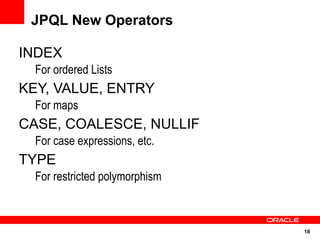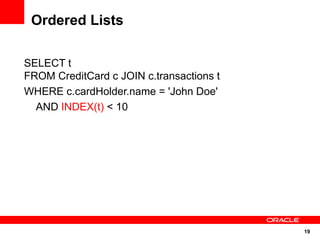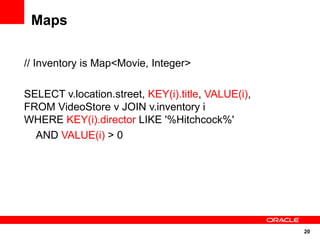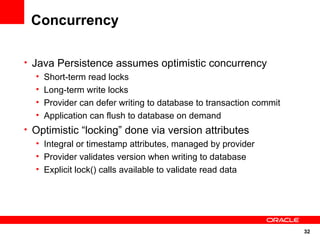Using the latest Java Persistence API 2 Features - Tech Days 2010 India
- 1. <Insert Picture Here> Using the Latest Java Persistence API 2.0 Features Arun Gupta, Java EE & GlassFish Guy blogs.sun.com/arungupta, @arungupta
- 2. Java Persistence API Object/Relational Mapping for Java Developers • The standard API for object/relational persistence for Java SE and Java EE applications • Automatic mapping from Java object domain model to relational database • Mapping is explicit, not “magic” • Uses annotations and/or XML • Many useful defaults • Lots of hooks and options for customization • SQL-like query language (JPQL) • Applied to domain model • Supports both static and dynamic queries 2
- 3. Background • JPA 1.0 • Introduced as part of Java EE 5; also available standalone • Part of the EJB 3.0 simplification effort • Based on experience with existing technology: • TopLink, Hibernate, JDO • Covered all the essentials++ 3
- 4. JPA 2.0 (JSR 317) • JPA 2.0 • Part of Java EE 6 and/or available standalone • Adds more sophisticated mapping and modeling options • Expanded query language • Adds Criteria API, together with Metamodel API • Support for Validation • EclipseLink is reference implementation • Integrated in GlassFish 4
- 5. Object/Relational Mapping Essentials • Entities • Basic types • Strings, integers, floats, decimals, … • Embeddable classes • E.g., Address • Relationships • One-to-one, one-to-many/many-to-one, many-to-many • Collections modeled with java.util Collection, Set, List, or Map • Customized via metadata: @JoinColumn, @JoinTable, etc. • Inheritance • Single table, joined subclass, table per class (optional) 5
- 6. Object/Relational Mapping New in JPA 2.0 • Element collections • Collections of strings, integers, floats, decimals, … • Collections of embeddable classes • Embeddable classes • Nested embeddables; embeddables with relationships • Persistently ordered lists • Improved Map support • More relationship mapping options • Unidirectional one-many foreign key mappings • Join table mappings for one-one, one-many/many-one 6
- 7. Collections of Basic Types @Entity public class Person { @Id protected String ssn; protected String name; protected Date birthDate; . . . @ElementCollection protected Set<String> nickNames; } 7
- 8. Collections of Basic Types @Entity public class Person { @Id protected String ssn; protected String name; protected Date birthDate; . . . @ElementCollection @CollectionTable(name=”ALIAS”) protected Set<String> nickNames; } 8
- 9. Collection of Embeddable Types @Embeddable public class Address { String street; String city; String state; . . . } @Entity public class RichPerson extends Person { . . . @ElementCollection protected Set<Address> vacationHomes; . . . } 9
- 10. Multiple Levels of Embedding @Embeddable public class ContactInfo { @Embedded Address address; . . . } @Entity public class Employee { @Id int empId; String name; ContactInfo contactInfo; . . . } 10
- 11. Embeddables with Relationships @Embeddable public class ContactInfo { @Embedded Address address; @OneToMany Set<Phone> phones; . . . } @Entity public class Employee { @Id int empId; String name; ContactInfo contactInfo; . . . } 11
- 12. Ordered Lists @Entity public class CreditCard { @Id long cardNumber; @OneToOne Person cardHolder; . . . @OneToMany @OrderColumn List<CardTransaction> transactions; } 12
- 13. Maps @Entity public class VideoStore { @Id Integer storeId; Address location; . . . @ElementCollection Map<Movie, Integer> inventory; } @Entity public class Movie { @Id String title; @String director; . . . } 13
- 14. Automatic Orphan Deletion For entities logically “owned” by “parent” @Entity public class Order { @Id int orderId; . . . @OneToMany(cascade=PERSIST, orphanRemoval=true) Set<Item> lineItems; . . . } 14
- 15. Key Interfaces • EntityManagerFactory • Used to create entity managers • One entity manager factory per persistence unit • EntityManager • Used to manage persistence context • Entities read/written from database • Operations: persist, remove, find, refresh, createQuery,… • Query, TypedQuery • Used for query configuration, parameter binding, query execution 15
- 16. Java Persistence Query Language • String-based SQL-like query language • SELECT, FROM, WHERE, GROUP BY, ORDER BY,… • Queries written over Java domain model • Entities, state, relationships • Supports navigation using dot-notation • Mapped into SQL by the provider • Supports static and dynamic use SELECT AVG (p.price) FROM Order o JOIN o.products p WHERE o.customer.address.zip = ‘94301’ 16
- 17. Java Persistence Query Language New in JPA 2.0 • Support for all new modeling and mapping features • Operators and functions in select list • Case, coalesce, nullif expressions • Restricted polymorphism • Collection-valued parameters for IN-expressions 17
- 18. JPQL New Operators INDEX For ordered Lists KEY, VALUE, ENTRY For maps CASE, COALESCE, NULLIF For case expressions, etc. TYPE For restricted polymorphism 18
- 19. Ordered Lists SELECT t FROM CreditCard c JOIN c.transactions t WHERE c.cardHolder.name = 'John Doe' AND INDEX(t) < 10 19
- 20. Maps // Inventory is Map<Movie, Integer> SELECT v.location.street, KEY(i).title, VALUE(i), FROM VideoStore v JOIN v.inventory i WHERE KEY(i).director LIKE '%Hitchcock%' AND VALUE(i) > 0 20
- 21. Case Expressions UPDATE Employee e SET e.salary = CASE e.rating WHEN 1 THEN e.salary * 1.05 WHEN 2 THEN e.salary * 1.02 ELSE e.salary * 0.95 END 21
- 22. Restricted Polymorphism SELECT e FROM Employee e WHERE TYPE(e) IN :empTypes 22
- 23. Criteria API New in JPA 2.0 • Object-based API for building queries • Designed to mirror JPQL semantics • Strongly typed • Based on type-safe metamodel of persistent classes and relationships • Heavy use of Java generics • Supports object-based or string-based navigation • Query construction at development time or runtime 23
- 24. Criteria API: Core Interfaces • CriteriaBuilder • Used to construct criteria queries, selections, predicates, orderings • CriteriaQuery • Used to add / replace/ browse query elements • from, select, where, orderBy, groupBy, having,… methods • Root • Query roots • Join, ListJoin, MapJoin, … • Joins from a root or existing join • Path • Navigation from a root, join, or path • Subquery 24
- 25. How to Build a Criteria Query EntityManager em = …; CriteriaBuilder cb = em.getCriteriaBuilder(); CriteriaQuery<ResultType> cquery = cb.createQuery(ResultType.class); Root<MyEntity> e = cquery.from(MyEntity.class); Join<MyEntity, RelatedEntity> j = e.join(…); … cquery.select(…) .where(…) .orderBy(…) .groupBy(…); TypedQuery<ResultType> tq = em.createQuery(cquery); List<ResultType> result = tq.getResultList(); 25
- 26. Validation New in JPA 2.0 • Leverages work of Bean Validation (JSR 303) • Automatic validation upon lifecycle events • PrePersist • PreUpdate • PreRemove • Validation-mode element in “persistence.xml” • AUTO, CALLBACK, NONE • Standardization of many configuration options 26
- 27. Sample Database Card TX Supplier Product Customer CreditCard Supplier Phone Orders Product Book DVD CD 27
- 28. Metamodel • Abstract “schema-level” view of managed classes • Entities, mapped superclasses, embeddables • Accessed dynamically • EntityManagerFactory.getMetamodel() • EntityManager.getMetamodel() • And/or materialized as static metamodel classes • Used to create strongly-typed criteria queries • Spec defines canonical format 28
- 29. Generating Static Metamodel javac -processor org.eclipse.persistence.internal.jpa.modelgen.CanonicalM odelProcessor -sourcepath src -d src -classpath /ace2_apps/eclipselink/jlib/eclipselink.jar:.:/ace2_apps /eclipselink/jlib/JPA/javax.persistence_2.0.0.v200911271 158.jar -proc:only -Aeclipselink.persistencexml=src/META- INF/persistence.xml src/demo/*.java Note: Creating the metadata factory … Note: Building metadata class for round element: demo.Item . . . http://weblogs.java.net/blog/lancea/archive/2009/12/15/generating-jpa-20-static-metamodel-classes-using-eclipselink-20-and-n 29
- 30. Entity Class package com.example; import javax.persistence.Entity; import javax.persistence.Id; import javax.persistence.Embedded; import javax.persistence.OneToMany; import java.util.Set; @Entity public class Customer { @Id int custId; @Embedded Address address; @OneToMany Set<Order> orders; … } 30
- 31. Metamodel Class package com.example; import javax.annotation.Generated; import javax.persistence.metamodel.SetAttribute; import javax.persistence.metamodel.SingularAttribute; import javax.persistence.metamodel.StaticMetamodel; @Generated(“EclipseLink JPA 2.0 Canonical Model Generation”) @StaticMetamodel(Customer.class) public class Customer_ { public static volatile SingularAttribute<Customer,Integer> custId; public static volatile SingularAttribute<Customer,Address> address; public static volatile SetAttribute<Customer,Order> orders; … } 31
- 32. Concurrency • Java Persistence assumes optimistic concurrency • Short-term read locks • Long-term write locks • Provider can defer writing to database to transaction commit • Application can flush to database on demand • Optimistic “locking” done via version attributes • Integral or timestamp attributes, managed by provider • Provider validates version when writing to database • Explicit lock() calls available to validate read data 32
- 33. Pessimistic Locking New in JPA 2.0 • Java Persistence assumes optimistic concurrency • Normal pessimistic locking • Persistent state of entity • Relationships, Element collections • Grab database locks upfront • JPA spec defines semantics, not mechanism • Provider can lock more (not less) • Lock modes • PESSIMISTIC_READ – grab shared lock • PESSIMISTIC_WRITE – grab exclusive lock • PESSIMISTIC_FORCE_INCREMENT – update version 33
- 34. Locking APIs • EntityManager methods: lock, find, refresh • Query / TypedQuery methods: setLockMode, setHint • NamedQuery annotation: lockMode element • javax.persistence.lock.scope property • javax.persistence.lock.timeout hint • PessimisticLockException (if transaction rolls back) • LockTimeoutException (if only statement rolls back) 34
- 35. Caching Configuration New in JPA 2.0 • EntityManager persistence context corresponds to “first level” cache • Entities managed by persistence provider • Entities read from database • Entities to be written to database • Most implementations also use second-level caches • Not always transparent to application • JPA 2.0 standardizes basic second-level cache options 35
- 36. Standard Configuration Properties • javax.persistence.jdbc.driver • javax.persistence.jdbc.url • javax.persistence.jdbc.user • javax.persistence.jdbc.password • ... 36
- 37. Summary of JPA 2.0 New Features • More flexible modeling capabilities • Expanded O/R mapping functionality • Additions to Java Persistence query language • Criteria API • Metamodel API • Pessimistic locking • Support for validation • Standardization of many configuration options 37
- 38. <Insert Picture Here> Using the Latest Java Persistence API 2.0 Features Arun Gupta, Java EE & GlassFish Guy blogs.sun.com/arungupta, @arungupta






































